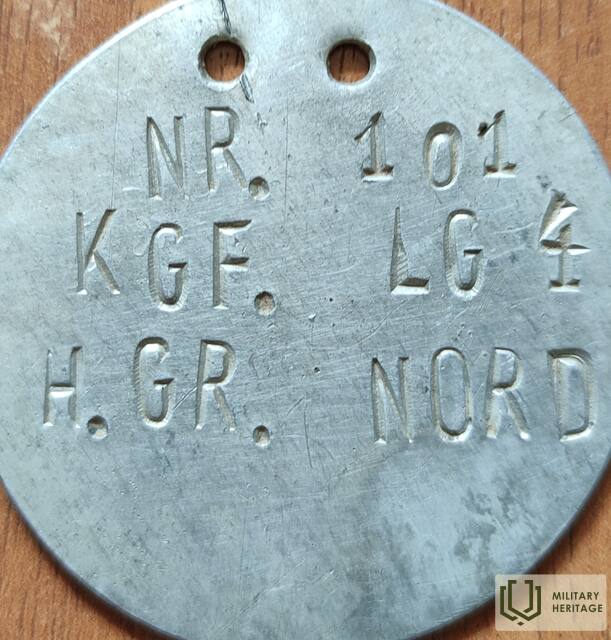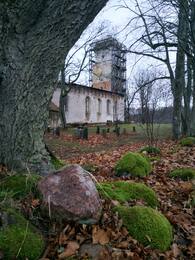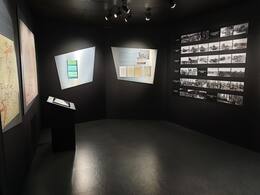Atradimas Grieze filtracijos stovyklos vietoje
Grieze filtracijos stovyklos teritorijoje ir pakelėse, vedančiose į ją, dažnai randami įvairūs buvusiems kareiviams priklausę daiktai. Kareiviai, suimti civiliai, karo belaisviai ir kt. jais atsikratydavo dėl įvairių priežasčių – tiek norėdami išvengti identifikavimo, tiek norėdami išvengti „ypatingo dėmesio“.
Vokietijos ginkluotųjų pajėgų armijų grupės „Šiaurė“ 4-ojoje karo belaisvių stovykloje kalinto karo belaisvio atpažinimo ženklas, tikriausiai išduotas Vokietijos-Sovietų Sąjungos karo pradžioje. Jis buvo rastas Grieze stovyklos vietoje, kur buvę Raudonosios armijos kareiviai taip pat buvo filtruojami.
Po armijų grupės „Kurzeme“ kapituliacijos Raudonosios armijos Leningrado fronte į nelaisvę pateko 284 171 žmogus. 7493 buvo Raudonosios armijos kareiviai, paleisti iš vokiečių nelaisvės. Į nelaisvę pasidavė 48 vokiečių generolai. Remiantis armijų grupės „Kurzeme“ kapituliacijos metu pateiktais dokumentais, kareivių skaičius buvo apie 185 000. Likę iš beveik 100 000 filtruotinų žmonių buvo Kuržemės civiliai gyventojai ir sovietiniai pabėgėliai, nes 1945 m. gegužės 10 d. Sovietų Sąjungos Leningrado frontas įsakė filtruoti visus vyrus nuo 16 iki 60 metų amžiaus.
Raudonojoje armijoje, skirtingai nei kitų šalių ginkluotosiose pajėgose, karo belaisvių patikrą, apsaugą, priežiūrą ir priežiūrą vykdė ne armijos daliniai, o vidaus reikalų organai – Valstybės saugumo liaudies komisariatas. Pagrindinė filtracijos užduotis buvo aptikti SSRS ir sovietų okupuotų šalių piliečius, dalyvavusius karo veiksmuose Vokietijos pusėje. Buvo tiriami paimti į nelaisvę vokiečių kareiviai, siekiant nustatyti galimus karo nusikaltimų vykdytojus.
Nuo 1945 m. gegužės 10 d. iki birželio 17 d. netoli Griezės bažnyčios buvo įsikūrusi karo belaisvių filtracijos stovykla. Stovykla tikriausiai čia buvo įsikūrusi todėl, kad Griezės bažnyčia buvo netoli pagrindinių kelių. Apylinkėse vis dar aiškiai matomos duobės žemėje, kuriose kaliniai šaltomis naktimis slėpdavosi nuo šalčio, prisidengdami kuo tik pavykdavo. Šiuo laikotarpiu Raudonoji armija padarė didelę žalą bažnyčios interjerui (visi suolai buvo pašalinti – „karo reikmėms“, apgadinta sakykla, sunaikinti vargonai ir kt.). Pačiame bažnyčios pastate buvo įrengta skalbykla.
Ši ekspozicija dabar eksponuojama Antrojo pasaulinio karo pabaigos parodoje Ezerės muitinėje.
Susijusi laiko juosta
Susijusios vietos
Raudonosios armijos kalinių filtracijos stovykla Griezėje ir Griezės bažnyčia
Griežė yra Latvijos ir Lietuvos pasienyje, kur Vadakstės upė įteka į Ventą. Griežės bažnyčia buvo pastatyta 1580 m., tačiau parapija egzistavo dar iki 1567 m. Bažnyčia buvo kelis kartus perstatyta – 1769 m., 1845 m., o 1773 m. buvo įrengti pirmieji vargonai. Dėl įvairių priežasčių prarastas ir altorius, ir du varpai.
Bažnyčios sode yra kapinės, kuriose palaidoti bažnyčiai priklausę žmonės ir didikai. Vienas iš jų – „Grieze“ vargonininkas Friedrichas Barisas ir jo žmona Šarlotė, kuriems priešais bažnyčios zakristiją pastatytas paminklas. Pietinėje bažnyčios pusėje palaidoti 32 švedų kareiviai, žuvę Didžiajame Šiaurės kare. Kapinėse taip pat yra 110 vokiečių kareivių, žuvusių Pirmajame pasauliniame kare, kapai, kuriems 1930 m. pastatytas paminklas.
Antrojo pasaulinio karo metu bažnyčia nukentėjo, kai 1944 m. spalio pabaigoje fronto linija buvo ištempta palei Ventos upę, o Griezės bažnyčios apylinkėse buvo dislokuota vokiečių 225-oji pėstininkų divizija. Kai 1944 m. lapkričio 19 d. sovietų 4-oji smogiamoji armija pradėjo atakas per Ventos upę, keli artilerijos sviediniai pataikė į bažnyčios pietinę sieną, o bažnyčios bokštas buvo smarkiai apgadintas.
Po armijų grupės „Kurzeme“ kapituliacijos Raudonosios armijos Leningrado fronte į nelaisvę pateko 284 171 žmogus. 7493 buvo Raudonosios armijos kareiviai, paleisti iš vokiečių nelaisvės. Į nelaisvę pasidavė 48 vokiečių generolai. Remiantis armijų grupės „Kurzeme“ kapituliacijos metu pateiktais dokumentais, kareivių skaičius buvo apie 185 000. Likę iš beveik 100 000 filtruotinų žmonių buvo Kuržemės civiliai gyventojai ir sovietiniai pabėgėliai, nes 1945 m. gegužės 10 d. Sovietų Sąjungos Leningrado frontas įsakė filtruoti visus vyrus nuo 16 iki 60 metų amžiaus.
Raudonojoje armijoje, skirtingai nei kitų šalių ginkluotosiose pajėgose, karo belaisvių patikrą, apsaugą, priežiūrą ir priežiūrą vykdė ne armijos daliniai, o vidaus reikalų organai – Valstybės saugumo liaudies komisariatas. Pagrindinė filtracijos užduotis buvo aptikti SSRS ir sovietų okupuotų šalių piliečius, dalyvavusius karo veiksmuose Vokietijos pusėje. Buvo tiriami paimti į nelaisvę vokiečių kareiviai, siekiant nustatyti galimus karo nusikaltimų vykdytojus.
Nuo 1945 m. gegužės 10 d. iki birželio 17 d. netoli Griezės bažnyčios buvo įsikūrusi karo belaisvių filtracijos stovykla. Stovykla tikriausiai čia buvo įsikūrusi todėl, kad Griezės bažnyčia buvo netoli pagrindinių kelių. Apylinkėse vis dar aiškiai matomos duobės žemėje, kuriose kaliniai šaltomis naktimis slėpdavosi nuo šalčio, prisidengdami kuo tik pavykdavo. Šiuo laikotarpiu Raudonoji armija padarė didelę žalą bažnyčios interjerui (visi suolai buvo pašalinti – „karo reikmėms“, apgadinta sakykla, sunaikinti vargonai ir kt.). Pačiame bažnyčios pastate buvo įrengta skalbykla.
Paskutinės pamaldos bažnyčioje įvyko 1950 m., ir parapija nustojo egzistuoti. Po parapijos iširimo, vėliau prižiūrint Latvijos gamtos ir paminklų apsaugos draugijai, bažnyčia nebuvo suremontuota. Tačiau pastatas po stogu stovėjo iki septintojo–septintojo dešimtmečių. Bažnyčia buvo apgadinta per 1961 m. audrą, o 1968 m. likusius interjero elementus išgelbėjo Rundalės rūmų darbuotojai.
Nuo 2003 m. grupė bendraminčių iš Rygos parapijų dalyvauja bažnyčios tvarkymo ir restauravimo darbuose. Iki šiol bažnyčios sienos yra konservuotos, o bokštas restauruotas.
Ezerės kraštotyros saugykla „Muitas Nams“
Ezerės muitinė yra Ezerėje, netoli Saldaus-Mažeikių plento, Latvijos ir Lietuvos pasienyje. 1945 m. gegužės 8 d. šiame pastate buvo pasirašytas vadinamojoje „Kuršo kišenėje“ apsuptų Vokietijos armijos dalinių „Kurzeme“ (Kurlandas) kapituliacijos aktas. Manoma, kad Antrasis pasaulinis karas iš tikrųjų baigėsi Ezerėje. Muitinėje yra ekspozicija, kurioje aprašomi Antrojo pasaulinio karo pabaigos įvykiai, ir eksponatai, kuriuose išsamiai aprašoma Ezerės parapijos istorija nuo seniausių laikų iki šių dienų. 1945 m. gegužės 7 d. rytą Leningrado fronto vadas maršalas L. Govorovas išsiuntė armijų grupės „Kurzeme“ vadovybei ultimatumą sudėti ginklus. Kapituliacijos aktą susijusios šalys pasirašė gegužės 8 d., jame išsamiai aprašyta perdavimo tvarka, ginklų surinkimo punktai, pateiktini dokumentai ir informacija bei kitos praktinės priemonės.








